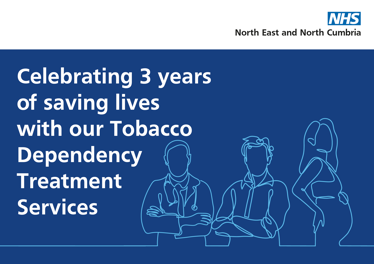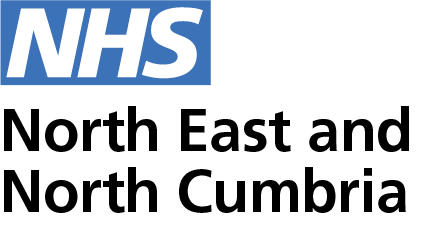A Personal Reflection on 3 Years of NHS Tobacco Dependency Treatment Services in NENC
It feels inconceivable now to think that the lifesaving benefits of in-house hospital Tobacco Dependency Treatment Services (TDTS) weren’t readily available in the North East and North Cumbria (NENC) as recently as 2021. Reflecting now, as we mark our three-year anniversary since all our ten TDTS began operating and delivering lifesaving and transformational services, feels surreal. That we have managed to make such a significant impact in such a short time - during a period of change and with the backdrop of the newly formed landscape of integrated care systems - is nothing short of remarkable.

When the NHS Long Term Plan was published in 2019, it was a welcome rallying call for the NHS to be a more powerful driving force in the battle against smoking, ensuring that everyone admitted to hospital who smokes or were pregnant would be offered help and support to quit. I remember vividly when I first started my role back in August 2021, the COVID pandemic had hit in 2020, and at its peak many services had been paused, with new services unable to start. Those services who were operational during the pandemic were still in recovery mode. The NHS LTP implementation had been pushed to the back burner and even the national early implementer sites that were meant to test this new approach hadn’t been able to mobilise. Starting this role, I was acutely aware of the challenges ahead: to provide system leadership and support the NENC to implement the NHS LTP tobacco dependency commitments. For many in the NHS, this was a brand new concept despite evidence from Ottawa in Canada and, closer to home, the CURE Model in Greater Manchester. Routinely screening smokers and providing onsite tobacco dependency treatment support for hospital inpatients or as part of routine maternity care was an unfamiliar model for many despite clinical guidelines from National Institute for Health and Care Excellence (NICE) and significant evidence on the positive impact of these interventions.
“Smoking cessation should be incorporated, as a priority, as a systematic and opt-out component of all NHS services as a complement to local authority services, and delivered in smoke-free settings. It is unethical to do otherwise” –
Royal College of Physicians (RCP), Hiding in Plain Sight Report (2018)
The NENC region had done lot of groundwork to shift the narrative and understanding of smoking and tobacco dependence. There had been significant progress in helping clinicians recognise that smoking and tobacco dependency wasn't a lifestyle choice, but was a chronic relapsing long-term condition – one that often begins in childhood, and that needs treatment. The NHS had, and continues to have, a unique and vital role to play in addressing this.
The Smokefree NHS taskforce, a multi-agency group set up in 2017 had provided ground-breaking leadership, laying the foundations through work on smokefree hospital sites and championing pockets of good practice around referrals to community stop smoking services (SSS) following identification whilst in hospital. So, I certainly didn’t start my role in a dearth of regional ambition or vision. System leaders in Fresh, OHID (Office of Health Improvement & Disparities - formerly Public Health England), Primary Care and Accountable Officers then in Clinical Commissioning Groups (CCG) had recognised the importance of this work and had started to commit to provide additional resource beyond the expected national allocation.
At this time in 2022, our smoking rates in the North East were still higher (13.1%) than the national average (12.7%), and our communities suffering disproportionately higher rates of cancer, respiratory illness, other smoking related conditions and premature deaths linked to smoking. The collective challenge was steep and personally I felt the weight of the task ahead. My first few months were indeed a baptism of fire. However, within a few months, the clinical lead & I were able to work closely with CCG accountable officers & key finance leads who had already made a commitment to identify and allocate the additional funding resource to all Trusts. This collective determination by our Population Health and Prevention Board enabled us to actualise our shared ambition of going further and faster, and run at scale to support mobilisation across all 10 Trusts and for 18 clinical pathways. And we did it, we got all the Tobacco Dependency Treatment Services in NENC up and running from September 2022.
In my role as the NENC Smokefree NHS Strategic manager, I needed to inspire others, share a clear vision, to assist in providing the tools and mechanisms, and help to shape the building blocks and infrastructure needed to deliver on this ambition. What followed were months of leading multipronged approaches to ensure we had consistency across all services. From language used to describe the TDTS, to how we communicated to patients, staff and partners, synchronising job descriptions/roles and even the quality of training on offer. We had several task and finish groups that we set up to look at job descriptions, communications, branding, data and more.
I was required to help develop a NENC implementation plan as requested by NHS England but also needed to support NHS Foundation Trusts to set up their own steering group meetings, develop local implementation plans and provide updates around their state of readiness to mobilise and start delivery. Tobacco Dependency Advisors & Service Managers were recruited and appointed, Trust Smokefree Leads, Clinical Leads & Executive Sponsors were identified/nominated. With time as teams became more established and local ownership grew, the intensive levels of support I was required to give reduced, and teams became more adept at providing updates around their Trust status and levels of delivery. We also set up infrastructure to have regular network meetings which served as safe place for challenge and sharing best practice which has been invaluable and some still remain to date
During this period, we implemented a range of supporting interventions to remove barriers and ensure establishment / full delivery of the TDTS. For example, to improve access to nicotine-based therapy for pregnant smokers, we established a NENC Maternity NRT vouchers’ scheme. We improved patient outcomes by encouraging our Trusts to utilise more evidence-based cessation tools, including the introduction of nicotine vapes across multiple pathways (initially as a pilot, then through the national Swap2Stop Scheme). Working jointly with the Best Start in Life programme, we introduced the NENC financial incentive scheme for pregnant smokers, as well as an inclusion of digital smoking cessation offer (Smokefree App), which has now been available to every smoker in the region since November 2021. We also commissioned multiple regional training sessions to ensure that high-quality interventions were delivered to patients, and the brand new workforce was equipped to then provide the right levels of support to patients who were identified as smoking, whether admitted to hospital or at maternity booking.
Of particular challenge was the data ask. We spent many painstaking hours trying to unpick what we might need to be collecting and because it took months before the data systems were approved by national teams it was a testing time. It probably took almost two years to get to the point where all our services felt confident in collecting and submitting data in a meaningful, consistent way. This is still not the case in every region even now, and so this is certainly down to the concerted effort in the early days trying to get baseline understanding from teams. I realise now as I reflect I could probably write several pages and talk for hours on all that we have accomplished collectively. I must pay tribute to everyone who has helped on this journey, every role no matter how seemingly small has contributed to this story, our story in NENC.
A few things stick out to me as instrumental to our journey and success to date:
1. Leadership: strong & visible system leaders in the Integrated Care System, including our Clinical lead for Tobacco, Prevention Board Chairs, ICB Medical Director, DPH Tobacco leads, all the ADPH NE DPH’s, and leadership from Fresh who host the programme roles.
2. Engagement & Collaboration: working closely with Local Authority SSS and Tobacco Commissioners, NECS, LMNS, all Trust Partners, ASH, Northern Cancer Alliance, NHS England & OHID and others has accelerated our progress.
3. Continuous Quality Improvement: the sustained focus on improving data quality and fostering a culture of continuous quality improvement has enabled us to identify gaps and proffer solutions faster.
4. Commitment to Evaluation: over the years, we have developed a strong commitment to commissioning independent evaluation of interventions and sharing learning broader.
5. Consistency: our desire to “do things once” has allowed us to do more, achieve economies of scale, maintain quality and avoid variation for patients as much as possible.
Highlights
It is quite hard to choose which project or intervention to highlight as indeed our programme has been very successful and we’ve had numerous high points. From showcasing our work at high profile international and national events, to been chosen to be pilot sites for NHS Staff Offer and an early implementer site for the Severe Mental Illness cessation work by NHS England. We have contributed to national documents and guidance such as with the NCSCT, successfully published our work in an academic journal, and everything in between.
However, if I had to choose two highlight to date I’d have to say the
i) Significant strides we have made in reducing maternal smoking rates by around 40% from 12.3% in 2021/22 to 7.8% in 2024/25 would be one. This is certainly a collective milestone however the progress over the last three years highlight impact of having our maternity TDTS teams
ii) My second would be the sheer scale of impact we’ve had. Since 2022 in the NENC, around 95,845 people have been identified as smoking on admission or at booking for maternity patients, and around 67,900 patients referred to in-house TDTS support to help with quitting or temporary abstinence whilst in hospital.
Looking ahead
I look forward to seeing how the new 10 Year Health Plan and the evolving role of ICBs’ in strategic commissioning impact the NHS and this area of work. While we’ve made huge progress, there is still much to do. Too many people continue to die from preventable causes linked to smoking, and inpatient and maternity pathways are only a small fraction of the daily NHS interactions - there are countless further opportunities to make every contact count. We must continue to seize these opportunities so that, in a few years’ time, we can truly achieve a smokefree future free from the death and disease from tobacco. You can find out more about our programme here
